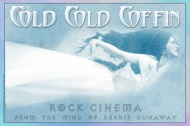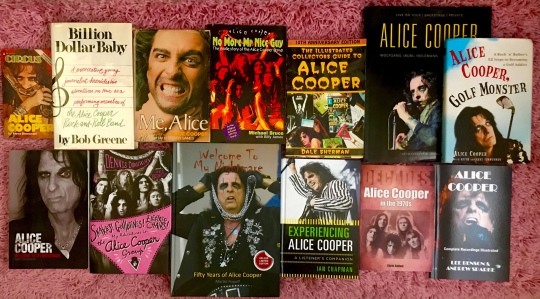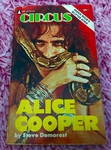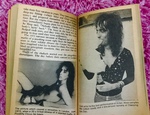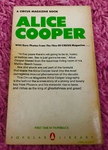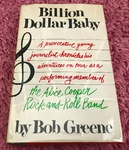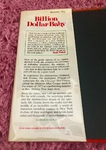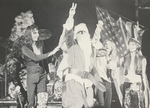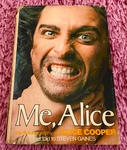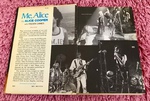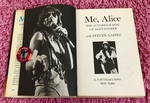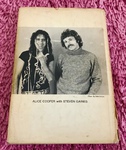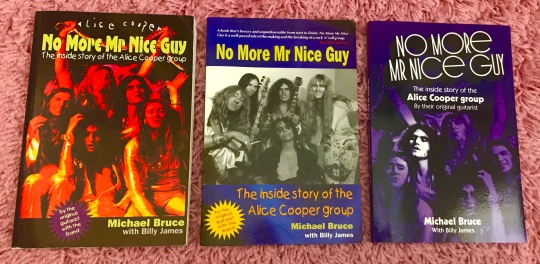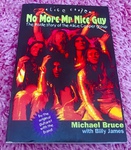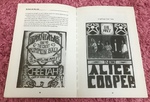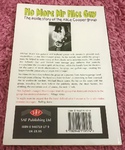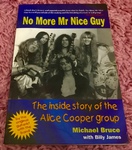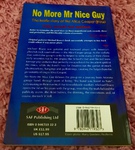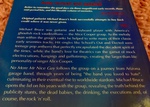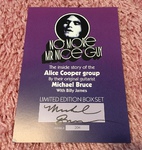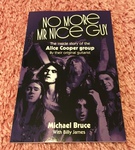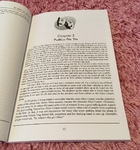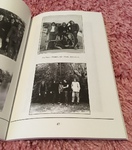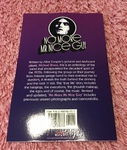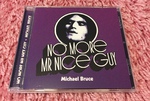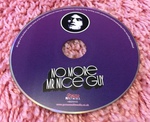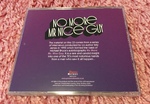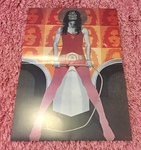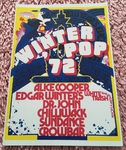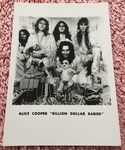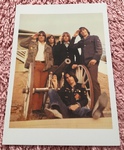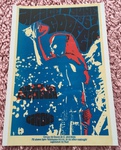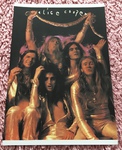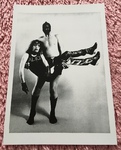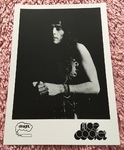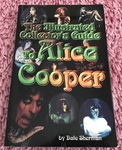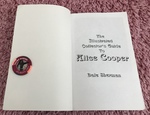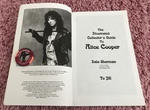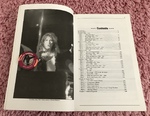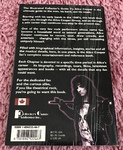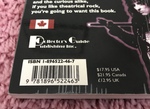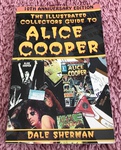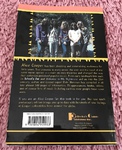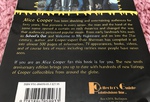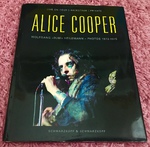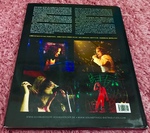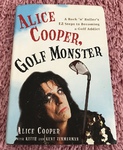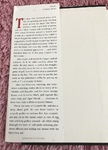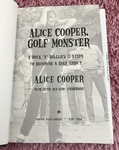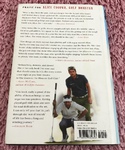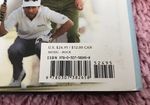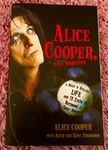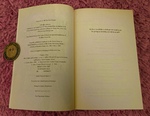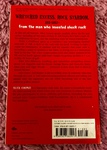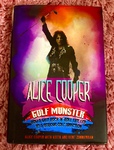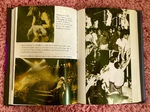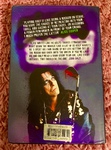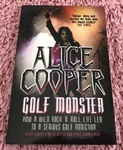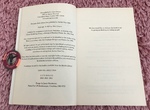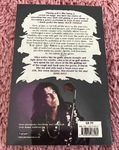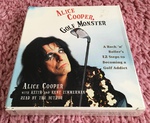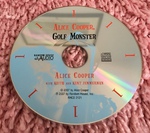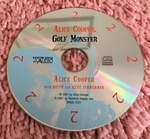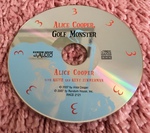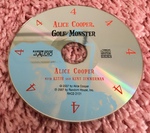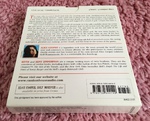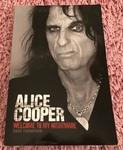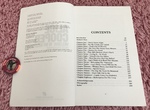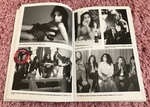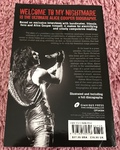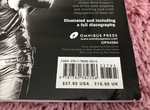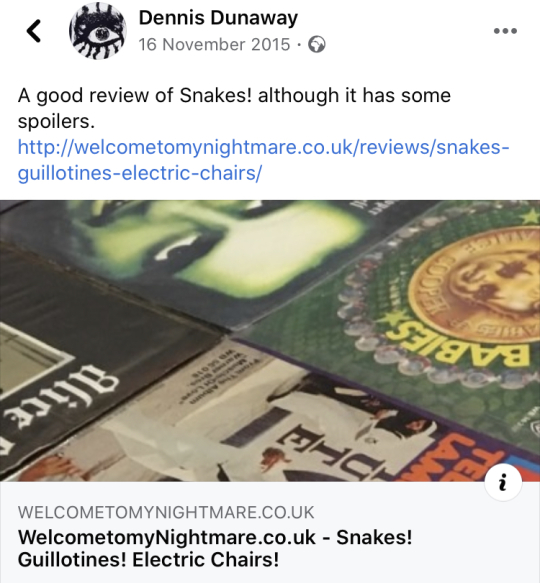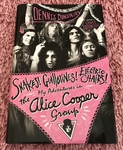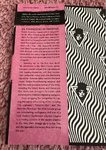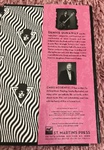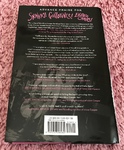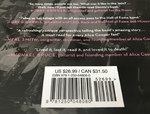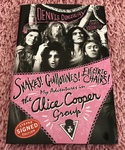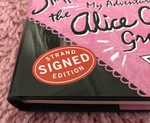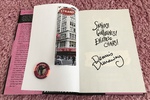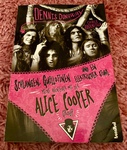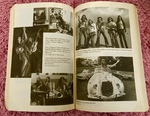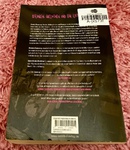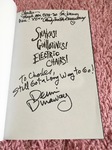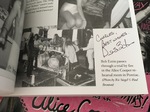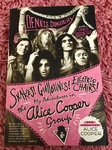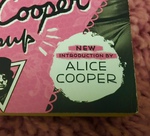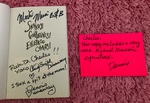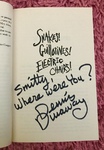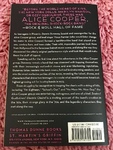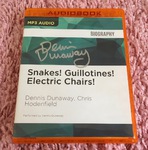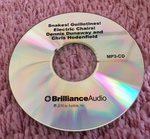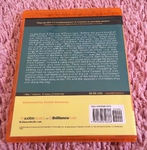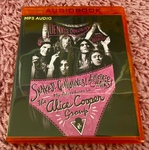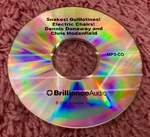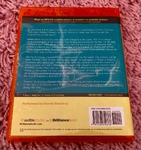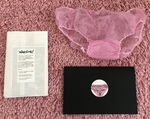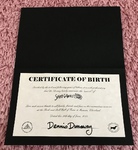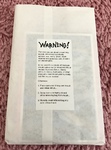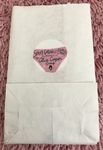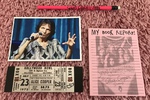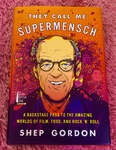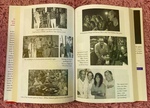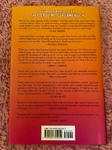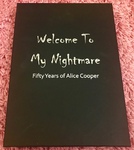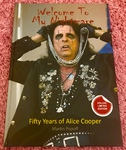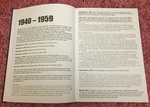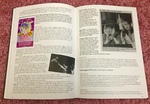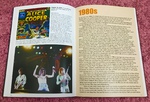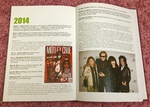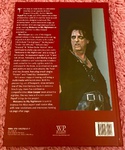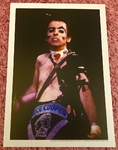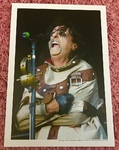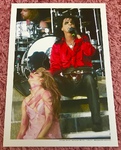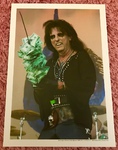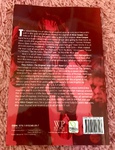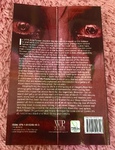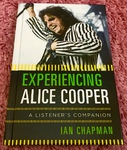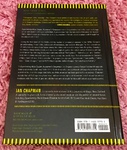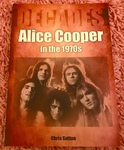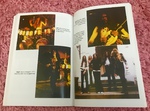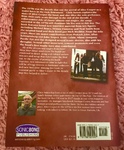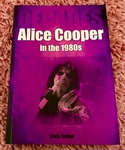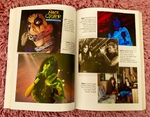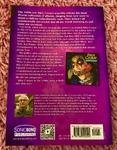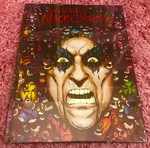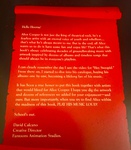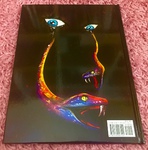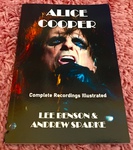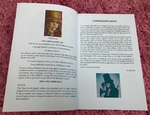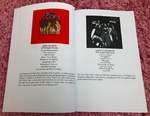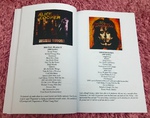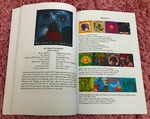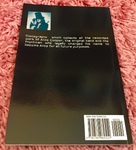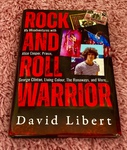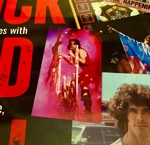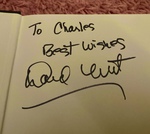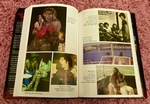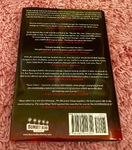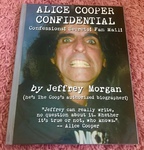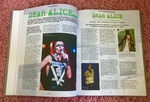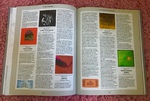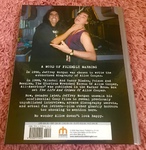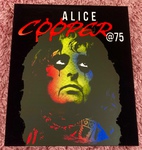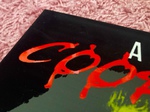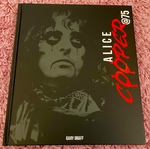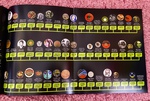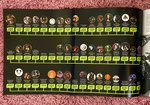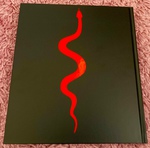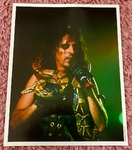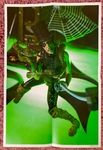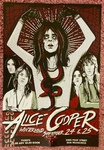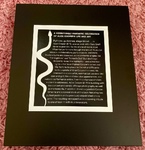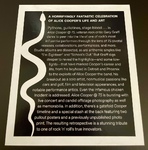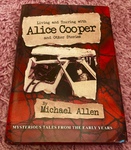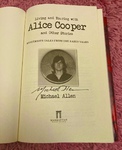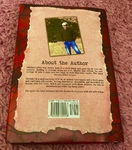Books
NOTE: For the Lace And Whiskey promotional book see here.
Alice Cooper, A Circus Magazine Book
This excellent 159-page paperback biography by Steve Demorest provides a detailed account of the Alice Cooper Group. Spanning 12 chapters, the material covers the Cortez High School days through to the Muscle Of Love period and the immediate aftermath. Although most of the material is now also available in some of the many other publications, this book still contains some really useful and unique insights into the rise and fall of the Alice Cooper Group. The book also includes detailed track-by-track guides of each album (i.e. Pretties For You through to Muscle Of Love).
Noteworthy content includes:
> The Ouija board story is used for how the Alice Cooper name was created;
> Cindy Smith is confirmed as the person who introduced Shep Gordon to the Group;
> A detailed background on the Group’s relationship with Frank Zappa and The GTOs;
> Moving to Detroit and the influence of Bob Ezrin;
> The impact of the live shows on audiences;
> Kachina the snake is referred to as Alice’s pet (not Neal’s);
> Moving to Connecticut;
> The infamous UK tours of 1972;
> The growing controversy caused by the Group and the attempts to have them censored;
> Confirmation that Elected was originally a 1968 Nazz song entitled You Shall Be Elected;
> Glen’s near-death experience in 1972;
> The Billion Dollar Babies USA tour of 1973;
> Alice’s growing dependence on alcohol; and
> Confirmation that Woman Machine was originally a Spiders song entitled Mr Machine.
The brief final chapter highlights that the Alice Cooper Group were beginning to head in different directions, with Alice starting to capitalise on his elevated star status. However, there is no indication that tensions in the Group existed, or that Glen was practically an outcast at this stage.
Also provided are a basic chronology and discography together with a number of great black-and-white photos from "the files of Circus Magazine". This book is quite hard-to-find these days but is essential reading for any hardcore fan.
Alice Cooper, A Circus Magazine Book
1974, Popular Library, 445-03046-150
This first edition of Alice Cooper, A Circus Magazine book (the only version produced) comes in paperback format and features an image of Alice with snake on the front and promotional text on the back.
Billion Dollar Baby
1974
Billion Dollar Baby is the now hard-to-find, and somewhat controversial, book by Bob Greene. This fly-on-the-wall publication documents Greene’s all-access time spent with the Alice Cooper Group during the recording of the Muscle Of Love album (in the fall of 1973) and the subsequent Billion Dollar Babies Holidays Tour at the end of the same year. When I say fly-on-the-wall I really mean it, as Greene was fully immersed in the rock and roll lifestyle. This included laying down un-credited backing vocals on two Muscle Of Love tracks (i.e. Hard Hearted Alice and Woman Machine) and playing the role of Santa during the end sequence of the Holidays Tour.
The book is a compelling read, placing the reader inside the Alice Cooper inner circle both at the height of their fame and during their decline as a functioning Group. Greene does a terrific job of making you feel there with him, by adding small but important details (for example, his account of witnessing a Billion Dollar Babies Tour show in Indianapolis is particularly captivating).
The book is also an important document of events of the time (and beforehand), which include:
> Fascinating descriptions of the wildly different personalities / lifestyles of the Alice Cooper Group (and numerous other pivotal individuals). In the case of Glen Buxton, the somewhat sobering description concludes that “Success had devastated him” and that “Underneath his rock and roll and jewellery, he had the lined, troubled face of a sorrowful old man”.
> Alice first started playing golf in California during the Summer of 1973 (where he was taught by PGA Tour pro Doug Sanders).
> Alice’s drinking was clearly excessive, with an evening routine of two six-packs of Budweiser beer followed by a switch at ~23:00 to a quart bottle of Seagram’s V.O. whiskey and Coke.
> The way the Group and associated support travelled on the Holidays Tour, including the use of the luxurious chartered Boeing 720 ‘Starship One’ jet.
> The less-than-enthusiastic / controversial approach that stage Alice portrayed during the Holidays tour. This disappointed Greene who states that “It was almost as if he wanted the crowd to know that the whole image upon which he built his fame on was a sham, a canard”. Greene later writes that Alice was not enjoying the tour generally, with various frustrations present including an inability (due to the weather) of being able to play golf!
> Alice’s dislike of the consumption (by his entourage) of drugs and pornography.
> The lavish lifestyle that the Alice Cooper Group had become accustomed to, including being waited on hand-and-foot by their Road Manager, David Libert, the unconditional adoration that would come their way from almost anyone they met and the excessive demands that were stipulated in the contracts with their concert promoters (e.g. limousines / chauffeurs and copious amounts of food and drink. This sums up nicely why they called themselves the Billion Dollar Babies, with Shep Gordon treating them like stars before they had even become them (which, in turn, gave them the confidence needed to achieve the status as the most successful act in the world).
> How Alice had begun the established member of the Group when it came to press conferences. Greene states that Shep Gordon eventually told the other members that they were “not wanted” as Alice was the best at it.
> The deep-rooted appreciation that the Alice Cooper Group had for their team of hard-working roadies, who were treated as part of the inner circle and got to enjoy many of the same comforts (e.g. travelling on Starship One and regularly hanging out with the Group).
> Insights into the marketing genius of Shep Gordon, who infamously gained the Alice Cooper Group worldwide exposure through the School’s Out paper panty / Flammable Fabrics Act stunt. Numerous examples are provided in the book of his business acumen, which helped make as much money as possible.
> How Shep Gordon was made aware of the Alice Cooper Group by Cindy Smith, when she was working as a seamstress in a boutique and mentioned that her brother played in a band.
> The highly erratic behaviour of Glen Buxton, which made him both unreliable and difficult to be around. Greene claims that at one show Glen casually re-appears on stage 45 seconds late whilst lighting up a cigarette. Rebecca Segal, the Group’s Road Secretary, is also stated as saying “I don’t really think that he’ll be alive at thirty-five”. Michael Bruce also confirms that he didn’t play on the Billion Dollar Babies album and that he could barely contribute on stage either. Glen only participated in a single, somewhat bizarre, interview for this book and he was observed as spending most of his time on the tour locked in his hotel rooms.
> A disastrous concert in Toledo, Ohio, that had to be abandoned after the Group left the stage for fear of their safety following crowd trouble. In order to protect their reputation, Shep Gordon invented a story that Michael Bruce was injured and couldn’t continue.
> The growing unease amongst the other Group members (especially Michael Bruce and Neal Smith) about Alice’s increased prominence. This was highlighted particularly in an infamous moment after a concert in Toronto, where a limousine chauffeur asked them to move to another vehicle so that Alice wouldn’t have to walk further than he needed to leave a venue (this drew an irate response from Neal in particular). Dennis Dunaway, however, was more accepting of the situation, with him describing Alice as being “special” in one of the few interactions he and Cindy Smith had with Greene.
> A concert in Binghamton, New York was cancelled (despite the best efforts of Shep Gordon) due to the locals discontent about the image of Alice Cooper.
> Neal Smith’s sheer enjoyment of being a rock star, his love of capitalism and an uncharacteristic night on the Holidays tour where he went on the rampage, causing thousands of pounds worth of damage to a hotel in Utica, New York.
> Ongoing issues with the transportation of the Billion Dollar Babies stage by lorry, which resulted in numerous concerts having to take place without it.
> The prevalence of groupies during the tour and their regular rendezvous with certain members of the Alice Cooper entourage.
> Alice’s (and Shep’s) reticence to discuss personal matters with Greene and other interviewers for fear of revealing that he wasn’t the same persons he played on stage (and the impact this would have on his / the Group’s reputation). However, he eventually tells Greene that he doesn’t want to be this version of Alice forever and confirms that he wants to try different, more wholesome, approaches to playing the character and appearing in movies etc. He also admits that he loves being a star and dislikes it when he isn’t recognised in public.
The book is considered controversial because it was presented in a manner that showed the Alice Cooper as a rather dysfunctional Group that had little or no unity. Although their hiatus would commence soon after, a number of Group members have protested that things were not as bad as they were reported here and that some of the good-humoured banter that they enjoyed was lost on, or simply ignored by, Greene. Examples of the controversial content include:
> Alice stating that Neal Smith was largely ignored by the Group members when it came to song writing at that he should release an album called ‘The Weak Link In The Super Race’.
> Upon the late arrival of Glen to rehearsals, Neal stating “Let’s just start without him. It doesn’t matter, anyway. We’ll probably sound better”.
> After the first few performances, Shep Gordon described the vocals as being “really bad” and that the situation was “pathetic” before insisting that all members of the Group put in some practice before the next show. This perceived shortfall was backed up by touring musician Bob Dolin, who was noted to irritate Alice by stating that “We hardly went through any of the harmonies in New York” (where a short rehearsal took place).
In subsequent interviews, members of the Group have stated that the book had been a partial factor in their subsequent falling apart the following year.
Numerous typos aside, this is an essential read for all Alice Cooper fans that are able to track a copy down.
Billion Dollar Baby
1974, Altheneum
This first edition of Billion Dollar Baby comes in hardback format and features text on the front of the dust sleeve and an image of Bob Greene with Alice (complete with makeup) on the back.
In the centre of the book are a number of photos of Greene performing as Santa during the Billion Dollar Babies Holidays Tour together with images of key figures from the book.
Me, Alice
1976
Me, Alice is a hard-to-find autobiography released in 1976. It was only available in the USA, in hardback format, and is today a sought-after item. Up until the release of Golf Monster (below) in 2007, this was the only such publication on Alice Cooper the man.
Although it's stated as being an autobiography, it's actually more of a hybrid autobiography-come-biography. The reason for this is that Alice's story is told by author Steven Gaines, who spent a long time researching Alice's past and also a considerable amount of time with Alice in person prior to its release.
Alice, however, is known not to like the book that much. But why is this the case?
Well, firstly, there's a less than glowing introduction by his father, Ether Moroni Furnier. In it he expresses his regret at the path that his son had chosen in life and the hope that he may one day become a "servant of God who can be as influential to the youth of the country for good as he has been for the adversary". The honesty of his comments are powerful but, in reality, Alice is understood to have had an excellent relationship with his father and the fact that it was included probably reflects this, or that it simply served as a good means to tempt browsers into a purchase. Either way, it’s fair to say that Alice certainly did ultimately answer his father’s wishes through his work with the Solid Rock Foundation (founded in 1995, 8 years after he passed away).
The other reason why Alice isn't keen on this book is that, in his opinion, it's not very accurate. Ironically, it is likely that he is to blame for much of this as many of the accounts that he provided Gaines were either fabricated, distorted by the impacts of alcohol or true, but regrettably so. There is some fairly juvenile bad language and sexual references throughout, that are both needless and seem out-of-character for Alice based on Bob Greene’s Billion Dollar Baby book (above).
Regardless of these issues, this book forms an important part of Alice's past and contains the following key information / topics:
> Alice states that the most important thing in his life is to be the most different and to do the opposite of what was expected.
> How a bought of peritonitis nearly killed him when he was 13 years old, with his recovery taking over a year.
> How Alice first met Glen Buxton whilst both working for the Cortez High School newspaper ‘The Tip Sheet’ and Dennis Dunaway / John Speer on the Cortez track team. He later managed to persuade them to form The Earwigs for the Letterman’s Talent Show in 1964 (John Tatum, a friend of Glen’s would join later to complete the line-up).
> Alice claims that their debut 7” single Why Don’t You Love Me was subject to only 50 pressings with half purchased by the band and the other half left to rot in a Phoenix record store.
> Alice names Mike Allen (Roadie), Dick Christian (Manager) and Charlie Carnal (Technician) as three important people in his life who become integral parts of the future Alice Cooper Group.
> The struggle to make it in Los Angeles as The Nazz and the change in personnel (i.e. Michael Bruce and Neal Smith replacing John Speer and John Tatum) that resulted in the final line-up of the future Alice Cooper Group.
> The renaming to Alice Cooper (following a suggestion by Vince that it was both “so American and eerie at the same time”) and the highly negative reaction that it drew from audiences, including the infamous Lenny Bruce Birthday Celebration.
> The incident where Alice shot Neal in the foot by mistake, resulting in Neal not being compulsorily drafted into the military.
> The freeway accident in 1968 that nearly killed the Alice Cooper Group. Alice and co. would later claim that they all died in this incident and were reborn as the Alice Cooper Group!
> Meeting The GTOs and the subsequent introduction by Miss Christine to Producer Frank Zappa (who wanted to rename the Group as Alice Cookies).
> The role Cindy Smith played in introducing the Group to Shep Gordon and Joey Greenberg, who would become their longstanding Manager and Assistant Manager respectively.
> The negative reaction to the Pretties For You album, which Alice proclaims that “people hated in their droves” but also states that it later become “a classic years later in Germany”.
> The Group’s battle to survive with little / no money and some of the unsavoury practices they had to lower themselves to get (e.g. avoiding paying hotel bills).
> Meeting his long-term girlfriend of the time, Cindy Laing.
> Alice strongly proclaims “I’ll never marry”.
> Falling out with Frank Zappa and going their separate ways.
> The chicken incident at the Toronto Rock N’ Roll revival concert in 1969.
> The unsuccessful Easy Action album and the damage that this further failure had on Alice’s confidence that the Group would ultimately succeed.
> Moving to Pontiac Farm in Detroit (where the popularity of the Alice Cooper Group was quite high), meeting Producers Jack Richardson and Bob Ezrin, and recording the successful LITD.
> Developing ways for Alice to die on stage, including the Cage Of Fire, the electric chair, the gallows and the guillotine.
> The introduction of Kachina the snake to the live shows.
> The Killer album and their first tour of Europe, where they were warmly received amidst attempts to have them banned by some authorities.
> The success of School’s Out including the infamous paper panties stunt.
> Alice and Glen Buxton’s battle with alcoholism including the devastating toll it took on Glen’s health.
> The Billion Dollar Babies album / tour, its objective to make the Alice Cooper Group gross earnings of $20 over a short period of time and the physical and emotional impact it had on them. Alice states that it “took the life out of the band” and that his role as the spokesperson for the Group meant that the press and the public became interested in him only. Alice also specifically mentions the damaging impact that Bob Greene’s Billion Dollar Baby book (above) had on the Group’s relationship with one-another.
> Alice ends the book by revealing that he is much healthier, plays golf with a passion and briefly mentions the success of his first solo album, Welcome To My Nightmare. He ends by stating that the book will be continued in 10 years and ”Don’t forget the Coop”.
It should be noted that the book contains several factual errors. These include, but are not necessarily limited to:
> Pretties For You is stated as being recorded in 1971 (two years after it was released!).
> Balled Of Dwight Fry is continually referred to as ‘Ballad Of Dwight Frey’.
> Alice claims that Kachina the snake was given to him by a girl in Florida, but it is well known that she was actually initially given to Neal Smith.
> The infamous truck in London is described as having broken down in Piccadilly Circus, but this actually happened at nearby Oxford Circus.
To summarise, the book is an interesting read but it has since been surpassed by other publications such as Dennis Dunaway’s excellent autobiography (below). Therefore, it doesn’t really justify its revered status and isn’t worth parting with huge sums of money unless you’re a hardcore fan who simply has to have everything Alice-related.
Me, Alice
1976, Putnam, SBN: 399-11535-8
I found this copy of Me, Alice on eBay from an extremely pleasant English-based seller. She was selling the book on behalf of her father but was also a big Alice fan herself (Alice apparently featured heavily in her university dissertation on 'theatricality and performance in rock and metal music', with this book being a key source of information). During our discussions over the purchase she was kind enough to provide the following information on the book from her father:
I had been to see Alice Cooper, for the first time, on the Special Forces tour in 1982, at the Hammersmith Odeon. My friend Mike knew I was a big fan and he ran a book and record shop; his book dealer had recently come back from a trip to San Francisco. Amongst other things he had brought back a copy of Me, Alice. And that is how I became the owner of the book.
No More Mr Nice Guy, The Inside Story Of The Alice Cooper Group
1996, 2000 and 2018
No More Mr Nice Guy, The Inside Story Of The Alice Cooper Group is the autobiography of Alice Cooper Group guitarist Michael (Mike) Bruce. Co-written by publicist Billy James, it was first released in 1996 in paperback only and then updated in 2000 (see below) with an additional Chapter 9 'Rock Rolls On' provided and some minor alterations to the previous text. It was then subject to further re-release in 2018 with a short epilogue added (see below).
The book is relatively short but its eight / nine chapters cover a lot of ground, from his early days in music through to the break-up of the Alice Cooper Group and his subsequent projects. As with other books on the Group, this again caused some controversy when it was released, but it seems that the strong feelings from all sides around the break-up of the Group will always provoke such a reaction as there does not appear to be a general consensus about it.
New / alternative material not previously covered in the previously released books (above) include:
> The influence of Elvis Presley, The Beatles, The Yardbirds, The Pretty Things and The Who on a young Mike.
> Meeting Glen Buxton, Dennis Dunaway, Vince Furnier, John Speer and John Tatum at Battle Of The Bands shows, when they were The Spiders and he was in the band The Trolls.
> Replacing John Tatum as the guitarist for The Spiders (whilst still secretly playing in another band, The Wild Flowers).
> Mike claims that the Alice Cooper name first came up when they were playing with a Ouija board (most other accounts suggest that Vince proposed it first).
> The influence of Neal Smith on the Group when he replaced John Speer as their drummer.
> How Vince assuming the role as Alice gradually saw the Group move away from the avant-garde ideas the Dennis originally had for them.
> The influence of Cindy Smith in developing the look of the early Alice Cooper Group.
> The meeting with a Los Angeles-based label, where they expressed interest in signing the Alice Cooper Group, providing they replaced Vince with a new singer.
> That several tracks on Pretties For You contain elements of songs from the James Bond Goldfinger soundtrack, played backwards!
> Confirmation that the infamous chicken incident in Toronto was instigated by the Group, who would bring their own chickens to their shows.
> Mike states that he always felt that Bob Ezrin had the impression that he, Dennis, Glen and Neal were “musically inferior” and that he “got the distinct impression that Joe [Greenberg] and Shep [Gordon] thought that the bad was just there to write songs and back Alice”. He also states that there was “considerable friction between Bob and me”.
> How Alice’s signature spider eye makeup was inspired by a brochure for the Alvin Ali dance troupe.
> The epic Halo Of Flies was the amalgamation of several unfinished songs.
> The Killer album and tour marked the pinnacle of the Groups equilibrium, with everyone contributing to their combined success in different ways.
> Their Technician, Charlie Carnal, was so influential that he was considered to be the sixth member of the Alice Cooper Group.
> Alice and Mike were the masterminds behind the lyrics to the hit single School’s Out (despite the others also receiving writing credits).
> The escalation of already present divisions in the Group during the Billion Dollar Babies album and tour with Mike stating that “Almost everything was being done without our knowledge or consent”.
> The major role that Glen’s rapidly declining behaviour / health had on Alice’s attitude towards the rest of the Group.
> The minimal song writing effort put in by Mike on the Muscle Of Love album and the impact that Bob Ezrin’s absence had on its eventual sound. He states that he likes the album but that “he wasn’t crazy about all the production” and that “we had really lost our hard edge”.
> The issues that Muscle Of Love’s unconventional packaging had on album distribution and sales.
> Glen being unplugged during live shows (due his sloppy playing) with Mick Mashbir playing instead.
> The world record indoor performance in Brazil, 1974 in front of 125,000 fans.
> On Alice’s continued rise as a solo star, Neal states that “I got the distinct impression that Alice thought the band was becoming an embarrassment to him and we were cramping his style”.
> Mike and Neal’s desire to record solo albums (In My Own Way and Platinum God) during time off for the Group after the Muscle Of Love album and Shep Gordon’s warning that “once you open the door for Alice to do a solo thing he might not come back”.
> How a lost lawsuit between Shep Gordon and Herb Cohen over publishing rights acted as the final nail in the coffin for the Alice Cooper Group.
> At the point that the Alice and the Group members settled up for the Alice Cooper name it was agreed that they would “get 3% of everything he did with the name after Welcome To My Nightmare”.
> The formation of the Billion Dollar Babies group and the principal reasons behind the failed Battle Axe album and tour.
> The Group nearly reformed in 1981 but Bob Ezrin refused to work with Dennis, Mike or Neal.
The additional material in the new chapter from the 2000 / 2018 re-issues includes the following content:
> Alice wasn’t happy with the book and “didn’t know whether to file it under fact or fiction”. Likewise, Glen “was a little upset” about it.
> Playing again with Glen and Neal shortly before Glen’s passing away from pneumonia in 1997.
> Playing with Alice at Cooperstown in 1998, which proved to be a turning point in their relationship.
> Mike’s hope that the surviving Alice Cooper Group members would reform one day and record / tour new music.
The short epilogue in the 2018 update references the following key events since 2000:
> The Alice Cooper Group’s induction to the Rock And Roll Hall Of Fame in 2011.
> The involvement of the surviving members of the Alice Cooper Group on Alice’s Welcome 2 My Nightmare and Paranormal solo albums.
> The variety of live shows involving the surviving members of the Alice Cooper Group, including the Live From The Astroturf performance in 2015.
> Forming the Michael Bruce Group.
Although this book has, in my opinion, since been largely surpassed by Dennis’ excellent 2015 autobiography (below), this is still an essential read for all Alice Cooper Group fans and well worth purchasing.
No More Mr Nice Guy, The Inside Story Of The Alice Cooper Group
1996, SAF Publishing Limited, 9 780946 719174
This is a first edition copy of No More Mr Nice Guy, The Inside Story Of The Alice Cooper Group. In addition to the content described above it is a rare collection of rare / never-before-seen photos and images taken from Michael's personal archive. These are located throughout the 154 pages.
Also provided at the back of the book is a short discography, which covers Mike's entire career at the time (i.e. From The Wild Flowers through to his post Alice Cooper Group releases as a solo artist).
No More Mr Nice Guy, The Inside Story Of The Alice Cooper Group
2000, SAF Publishing Limited, 9 780946 719327
This is the second edition of No More Mr Nice Guy, The Inside Story Of The Alice Cooper Group. This features an alternative cover and includes the additional Chapter 9 'Rock Rolls On' and some minor alterations to the previous text.
No More Mr Nice Guy Box Set
2018, Gonzo Multimedia
In 2018, this box-set was released via the Pledge Music crowdfunding programme, offering fans a second chance to obtain the No More Mr Nice Guy book plus a range of added goodies. Limited to just 250, individually numbered, units and provided in a cool black box with purple lining, the full contents were as follows:
> A paperback copy of No More Mr Nice Guy;
> A CD containing an interview conducted between Billy James and Michael Bruce in 1995 that formed the basis of the written material in the book;
> A numbered certificate signed by Michael Bruce (mine is #204); and
> A poster and prints reproducing classic Alice Cooper promotional material.
Overall, this set is really good and well worth having (even if you have the original book). The only downsides are that (a) the book is not a hardback edition (b) the quality of some of the images printed in both the book and the promotional material are rather ropey and (c) the images from the first edition have been reduced in number resulting in a shorter book (i.e. 120 pages instead of 154 pages). The retained images are also now all moved to the centre of the book with several resized (leading to the above mentioned quality issues).
Still, this shouldn't put you off buying this set (if you can find it).
The Illustrated Collector's Guide To Alice Cooper
1999 and 2009
This ambitious publication by Dale Sherman is a dream for fans / collectors as it provides information on all things Alice Cooper. Initially released in 1998 and featuring 301-pages, it covers the very early days at Cortez High School through to 1997’s A Fistful Of Alice live CD (the imminent The Life And Crimes Of Alice Cooper boxset is also mentioned a few times though).
Following a brief introduction and ‘Reading Guide’ (which amongst other things, includes useful information on the different types of record media) the book provides five core chapters covering the following periods:
> Chapter 1 – 1964-1974;
> Chapter 2 – 1975-1979;
> Chapter 3 – 1980-1982;
> Chapter 4 – 1984-1990; and
> Chapter 5 – 1991-1998.
Each chapter is broken down into the following parts:
> Part 1 - An overview of Alice’s career during the years covered;
> Part 2 - Official recordings released by Alice’s label in the years covered;
> Part 3 - Tours performed in the years covered;
> Part 4 - Film and television appearances in the years covered; and
> Part 5 - Books and comic books made in the years covered.
A further ‘Chapter 6 Luney Tune’ is then provided which covers the following:
> The 1969 Concert Albums;
> Compilation Albums;
> Soundtrack Albums;
> Guest Appearances;
> Performances by the Alice Cooper Group Members; and
> Bootleg Albums.
Finally, a short ‘Chapter 7 Acknowledgments’ is provided at the end.
Littered amongst the chapters are a range of interesting black-and-white and colour images / photos, which also help to break the text up.
Regrettably, and as with most other Alice Cooper books, numerous errors (some very sloppy) and omissions are present. There are far too many to list but include the following:
> Numerous typos;
> Flush The Fashion is named as the last Alice Cooper album to be released on 8-Track, but the subsequent Special Forces is also known to have been produced on this format (some even indicate that Zipper Catches Skin had an 8-Track release, but I've personally never seen a copy).
> Muscle Of Love is named as the last Alice Cooper album to feature cassette “slip-boxes”, but the subsequent Welcome To Nightmare was also available with these.
> The first vinyl edition of Pretties For You is initially stated as featuring a “pink label with Straight printed several times”. The book then (correctly) states that it featured an orange Straight label.
> Why Don’t You Love Me is described as a cover of a song by “The Mersey Beats”, but it was actually by The Blackwells (who were a ‘Merseybeat’ band).
> Easy Action is stated as being subject to a Japanese vinyl release in 1970, but I do not believe this is correct (my understanding is that Love It To Death was the first such release).
> Only a handful of entries for the Eighteen 7” release are listed (e.g. no Danish, Dutch or Portuguese versions are mentioned).
> The Dutch sleeve of the Elected 7” is pictured, but is incorrectly labelled as the UK version.
> Department Of Youth is listed as the first single from Welcome To My Nightmare, but it was actually Only Women Bleed.
> An image provided of 80s and 90s “Picture CD’s” is actually one of picture vinyl releases.
In addition to the errors, many of the album and single listings are very basic, with some only providing a product code and media type (so aren’t very useful).
Covering such a wide-spanning history / discography was always going to be difficult in book form, especially during the early days of the internet. However, if you acknowledge the above shortcomings then it’s still a good source of information to have. Just make sure you compare its content to other offerings to be sure you have the right information (dare I say it, this site and the great ones that I've provided links to).
Thankfully, a vastly improved ‘10th Anniversary Edition’ was released in 2009 which corrected many, but not all, of the errors from the original release. Additionally, at 474 pages (173 more than the original release), it featured enhanced content and is by far the superior of the two.
Noteworthy additional content of the 10th Anniversary Edition includes:
> Extended history covering the period 1999 to 2008 (i.e. the Brutal Planet to Along Came A Spider albums).
> Improved layout with lots more images (the nice colour images from the first edition are no longer present though);
> Enhanced Chapter 6 now including:
> Various Artists Compilation Sampler Albums;
> Radio Shows & Interview Discs;
> Tribute/Cover Albums;
> Toys; and
> Picture Index.
Chapter 7 is no longer present with the acknowledgments effectively absorbed into the introduction.
In summary, I can’t recommend the original publication, but the 10th Anniversary Edition is definitely worth having if you can find one (they are very rare now). Although the great web-based Alice Cooper resources (and the likes of Discogs) have made the need for a book like this largely redundant, the collector in me would love to see a further updated edition to be published as it's a great item to flick through from time-to-time!
The Illustrated Collector's Guide To Alice Cooper
1999, Collector's Guide Publishing Inc., 781896 522463
This first edition of The Illustrated Collector's Guide To Alice Cooper (the only version produced) comes in paperback format and features various images of Alice on the front and promotional text on the back.
The Illustrated Collectors Guide To Alice Cooper (10th Anniversary Edition)
2009, Collector's Guide Publishing Inc., 781894 959933
This first edition of The Illustrated Collector's Guide To Alice Cooper 10th Anniversary Edition (the only version produced) comes in paperback format and features various images of Alice Cooper memorabilia on the front and promotional text on the back together with an early photo of the Alice Cooper Group.
Alice Cooper, Live On Tour | Backstage | Private
2005, Schwarzkopfe & Schwarzkopfe, 9 783896 026514
This interesting 135-page hardback book by German photographer Wolfgang 'Bubi' Heilemann is primarily devoted to his photography of both the Alice Cooper Group and solo Alice between 1973 and 1975. As the title suggests, he had live, backstage and private access and was therefore able to take some intriguing, often candid, shots during a key period in time.
The photos taken are divided into the following shoots:
> The 1972 School's Out Tour show in Munich, Germany;
> A private shoot at Heilemann's photo studio the day after the above show;
> The 1972 Billion Dollar Babies Tour show in Detroit, USA;
> A 1972 party at an art gallery in New York with Salvador Dali; and
> The 1975 Welcome To My Nightmare Tour in Germany.
Minimal text is provided, but two pages of multilingual introductory material is provided before each of the above sections. Also provided is a very short biography, an 'Update' and information and acknowledgments. The written material is, being honest, somewhat disposable, but this is ok as the photos are the main attraction in this well-proportioned, good quality, publication.
Alice Cooper, Golf Monster
2007
Released 31 years after Me, Alice (above), the 250-page Golf Monster was the second autobiography about Alice and was written by twin authors Keith and Kent Zimmerman. As the title suggests, Alice’s beloved golf was to feature prominently, with his story accompanied with the following ‘12 Steps of Golf Addiction’:
1. Be a Good Imitator;
2. It Don’t Mean a Thing if You Ain’t Got That Swing;
3. Play for the Right Reasons;
4. Let the Adrenalin Flow;
5. Play on the Road! Play All Over the World!;
6. Confront Your Demons and Defeat Them;
7. Play with Those Who Inspire You;
8. Replace the Bad Addition with the Good Addiction;
9. Construct a Spiritual Support System That works for You;
10. Learn How to Play Through;
11. Pay Attention to Innovation and Technology; and
12. Keep on Rockin!
Whilst the golf content is quite heavy, it’s worth pointing out that plenty of analogies for the above are provided that relate to Alice’s music career. For example, for Step 4, he talks in detail about how adrenalin has influenced his ability to perform on stage over the years.
Elsewhere, a reasonable synopsis of his life and music career is provided covering 25 chapters. Much of it was already covered in similar detail in Me, Alice and, to a lesser extent, Michael Bruce’s autobiography (above) but this book obviously extends well beyond the release date of those (1976 and 1996 respectively). In summary, previously covered content includes:
> Background as a child growing up in Detroit, Los Angeles and Phoenix and his near death experience with peritonitis;
> The formation of The Earwigs and The Spiders.
> His introduction to alcohol.
> Dealing with the military draft and shooting Neal Smith in the foot;
> Moving to Los Angeles and becoming Alice Cooper;
> The freeway accident that nearly killed the Alice Cooper Group in 1968;
> Meeting the GTOs and Frank Zappa;
> The Toronto Rock N’ Roll revival concert and the chicken incident;
> Recording Love It To Death with Bob Ezrin and the success of I’m Eighteen;
> Recording the School’s Out and Billion Dollar Babies albums;
> Playing golf for the first time in 1973;
> The issues the Alice Cooper Group experienced during the Muscle Of
Love album and the frictions that developed between Alice and the other members; and
> Michael Bruce ignoring Shep’s warning not to record a solo album.
New or alternative insights from the same broad era include:
> How Shep Gordon was apparently responsible for the chicken incident;
> That the other Group members were not keen on the Welcome To My Nightmare idea and elected not to “take the ride”; and
> His close relationship with Shep and the faith he has always placed in him regarding his financial affairs.
In terms of new material, there is a reasonable amount on offer, including:
> The recording of The Alice Cooper Show in Las Vegas (and his dislike of the album);
> Meeting his future wife Sheryl during the Welcome To My Nightmare Tour (and rejecting Raquel Welch in the process);
> The perceived reasons for his alcoholism;
> His relationship with iconic celebrities like Andy Warhol, Elvis Presley, Peter Sellers, Salvador Dali, Groucho Marx and Frank Sinatra;
> Becoming a TV / movie star and appearing on The Muppet Show, The Tonight Show, Hollywood Squares, Something Wilder and Wayne’s World;
> Checking in to the Cornwell Medical Centre, New York in 1977 and the subsequent From The Inside album and tour;
> His relapse into alcoholism after taking a sip of some wine that Sheryl had ordered;
> Barely remembering the recording of the Flush The Fashion, Special Forces, Zipper Catches Skin and Dada albums in the 1980’s;
> Saving his marriage, cleaning up for good and becoming a golf addict;
> Releasing the Constrictor album, performing sober for the first time and the invention of a “brand new Alice”;
> The death of his father in 1988;
> His personal ‘Addiction List’;
> Becoming a born again Christian with “new guidelines” for Alice;
> Becoming Alice before a show;
> The positive impact of his Solid Rock Foundation and the annual Alice Cooper's Christmas Pudding fundraiser show; and
> His views on Marilyn Manson and the future of rock music.
Also provided is a host of interesting historical photos of Alice, a useful index and an ‘Alice’s Golf Clinic’ Appendix that features ’15 Tips for Achieving Your Best Game’.
There is plenty of material here to keep casual readers happy. Conversely, there is little provided for hardcore fans that wasn’t previously known at the time of release through one source or another. The most obvious omission is his drug abuse in the early 80’s that was subsequently revealed in 2014's Super Duper Alice Cooper film. In fact, he goes as far as to state in this book that he “wasn’t shooting heroin and I wasn’t snorting cocaine – none of that evil stuff” (although this is admittedly when he was talking about 1975).
On the subject of inaccuracies, there are a few claims in the book that simply don’t stack up:
> Alice claims that Shep Gordon was introduced to the Alice Cooper Group by Jimmy Hendrix. This seems to be in contrary to the often-told story that Cindy Smith (Dunaway) was the person that did this.
> Alice claims that I Never Cry “became the biggest hit single we ever had, even bigger than School’s Out”. This surely isn’t right as School’s Out charted much higher around the world.
Finally, a lot of Alice’s career is omitted here, with many of his solo albums mentioned only briefly, or worse, not at all. The Alice Cooper Group are also mentioned only a handful of times with nothing included about Glen Buxton’s death.
Overall, it’s still worth getting, but you can’t help but think that the definitive Alice autobiography still hasn’t been published. That said, I guess it would be almost impossible to shoehorn all of his remarkable life into a single book, plus one could argue that this one reflects his status as an all-round celebrity who, as Alice nicely sums up, is “woven into the American fabric”.
Alice Cooper, Golf Monster
2007, Crown Publishers, ISBN 978-0-307-38265-8
This USA first edition hardback copy of Alice Cooper, Golf Monster features a cover with Alice in full makeup 'holding' a superimposed golf club. The back cover features short endorsements by Michael Douglas, John Daly and others.
This copy has been personally autographed by Alice Cooper on the blank page at the front of the book.
Alice Cooper, Golf Monster
2008, Three Rivers Press, ISBN 978-0-307-38291-7
This USA re-issue paperback copy of Alice Cooper, Golf Monster features a slightly different cover to the first edition (above) with Alice now holding a golf ball (rather than a club). The back cover now features promotional text along with a short biography about Alice.
Alice Cooper, Golf Monster
2007, Aurum Press, ISBN 978 1 84513 292 2
This UK first edition hardback copy of Alice Cooper, Golf Monster features an alternative cover to the USA release (above) with Alice performing live whilst 'holding' a superimposed golf club. The back cover features an endorsement by golfer John Daly and a short quote from Alice.
Alice Cooper, Golf Monster
2008, Aurum Press, ISBN 978 1 84513 358 0
This UK re-issue paperback copy of Alice Cooper, Golf Monster features a similar cover to the first edition (above). The back cover now features added promotional text alongside the original content.
It is worth noting that all the photos in this edition are presented in black-and-white (a number were in colour in the first edition).
Alice Cooper, Golf Monster Audio CD
2007, Random House Audio, RHCD 2121
In addition to the paper-based versions of Golf Monster (above) an abridged four-hour audio version was released on both MP3 and CD format. The unique selling point of this version is that the story is narrated by Alice himself, this makes for compelling listening as we hear it from the horse's mouth (so to speak).
The CD version comes in card box and features a foldable case inside containing four discs. The back of the box features a brief description of the book and a short biography on Alice and Keith and Kent Zimmerman.
Alice Cooper, Welcome To My Nightmare
2012
This unauthorised biography by Dave Thompson provides a detailed history of ‘Alice Cooper’ to 2011 and spans nearly 300 pages and 18 chapters. The author states that “This book is not a biography of Vince Furnier” but instead “is concerned with the life that he created”. That said, it is overwhelmingly centred on Alice’s life rather than that of the Alice Cooper Group, although the others are at least referenced regularly during the pre-Alice Cooper to the Muscle Of Love eras. The Battle Axe album is also covered, but little is written about them thereafter.
One of the most notable aspects of the book is that it provides deep insights into areas like:
> Life in America and the prevailing music scenes during various points in time;
> Alice’s wider family;
> Acts that influenced Alice Cooper and, in turn, acts that Alice Cooper influenced;
> The Alice Cooper Group’s infamous UK visit in 1971; and
> The elaborate stage shows of the Alice Cooper Group.
As alluded to above, Alice’s solo career is well represented. Importantly, there is again much better coverage of the often overlooked Goes To Hell to Dada eras, plus varying levels of detail covering the Constrictor to Welcome 2 My Nightmare eras. Notable material from the latter years include:
> Flush The Fashion being described as a “desperate album”;
> Details of the divorce settlement that nearly took place between Alice and Sheryl in 1983;
> Information on his appearance in the film Monster Dog;
> The end of his record deal with Warner Brothers;
> The 1980’s horror movie stars, their similarities to the Alice character and their influence on the Constrictor and Raise Your Fist And Yell albums;
> The attempts to censor Alice’s work by the Parents Music Resource Center (PMRC) and Politicians in Europe;
> Alice’s relationship with Rob Zombie and Marilyn Manson; and
> The Alice Cooper Group Rock And Roll Hall of Fame induction in 2011.
Unfortunately, what has all the hallmarks of a good book is tainted by a number of notable errors. Many of them are extremely sloppy and include, but are not limited to, the following:
> Alice’s son is stated as Damien Furnier, rather than Dashiell (Dash) Cooper. Related to this, the book also states that Alice didn’t change his name legally until after Dash was born (in 1985), but this actually happened in 1974. Also, the supposed name of Damien was allegedly after his father’s middle name, but this isn’t right either as that was Damon. This issue is tidied up on the Audiobook version of this release, with the middle name comment changed to him being named after author Dashiell Hammett, but this is really poor as the original narrative is basically just made up!;
> It is initially stated that Alice wrote a theme for Nightmare On Elm Street. This isn’t correct as it was actually Friday 13th Part VI: Jason Lives (although he did also appear in Freddy's Dead: The Final Nightmare). This point is corrected later on in the book;
> As is often the case, the infamous broken down truck in London is described as having broken down in Piccadilly Circus, but this actually happened at nearby Oxford Circus;
> Department Of Youth is incorrectly titled The Department Of Youth;
> Disco Bloodbath Boogie Fever is incorrectly titled Disco Bloodbath Boogie;
> The Nightmare TV Special is stated as being released in 1984 rather than in 1975;
> Bed Of Nails is stated as a UK-only release, but it was also issued in Australia and Europe:
> Alice is quoted as saying that the Brutal Planet album was described as a ‘Tragic Waste Of Plastic. This is highly unlikely to be true as he is often heard attributing that remark to the Pretties For You album.
In his acknowledgments at the end of the book, Thompson credits interviews by him with Alice and a number of other key people. He also provides several references to both the Me, Alice and Alice Cooper, Golf Monster books (above), which makes the errors present even more baffling.
Also provided is a simple Discography, a handy index and a range of decent black-and-white and colour photographs covering the full career of Alice Cooper at the time.
In summary, this is a good book with some really deep insights (perhaps a little too deep at times) into some of the iconic moments of the Alice Cooper story. However, the multitude of irritating errors make for a far less rewarding experience than it should be. Also, Dennis Dunaway’s subsequent autobiography (below) has largely surpassed the Alice Cooper Group related material on offer here, but I think there is still room for this in hardcore fans’ collections. Like many books, a few error corrections and an update of subsequent events would make for a superior release.
Alice Cooper, Welcome To My Nightmare
2012, Omnibus Press, OP54384
This first edition paperback copy of Alice Cooper, Welcome To My Nightmare features a black-and-white image of a snarling Alice on the front. On the back is an image of Alice performing live with snake alongside promotional text. The images, provided at various points in the book, are printed on nice glossy paper making for an appealing overall product.
Not Only Women Bleed, Vignettes From The Heart Of A Rock Musician
2012, Desert Dreams, ISBN 978-0-9856843-0-3
Not Only Women Bleed is a book by acclaimed guitarist Dick Wagner, who worked with Alice Cooper (the Group and the solo artist) between 1972 and 2011 as well as other acts including Lou Reed and Kiss.
As the title suggests, this publication is more a collection of short stories rather than an autobiography. It contains eight parts in total, with the majority of two dedictated to his work with Alice. Notable content includes:
>
Also provided are numerous images / photos featuring his work with Alice Cooper plus two CDs featuring music by Dick.
Overall, this is an excellent book and well worth seeking out a copy.
Dick passed away in 2014, aged 71, having suffered a number of health issues in previous year.
Snakes! Guillotines! Electric Chairs!, My Adventures In The Alice Cooper Group
2015
'Snakes! Guillotines! Electric Chairs!, My Adventures In The Alice Cooper Group' was released in 2015 and is a personal account of the original Group by founding member / bassist Dennis Dunaway (with support from entertainment journalist Chris Hodenfield). The book, as you would expect, mainly focuses on the period that the Group, and its former incarnations, was active (about 1964 to 1974) but there are also chapters devoted towards the decline of Glen Buxton, Alice's struggles with drug addiction (in the 1980's) and the group's triumphant induction into the Rock and Roll Hall of Fame (2011).
Something that comes across very quickly is that Dennis writes with what feels like a refreshing tone of honesty, this endears himself to the reader and gives them the confidence that what's written is as close to the truth as you are ever likely to find given the passing of time. This is best evidenced through vivid memories of the young Glen Buxton and his first impression of future brother-in-law Neal Smith. Another good pointer is that Dennis is happy to share some of his less-than-successful moments as well the iconic ones. It's fair to say that Dennis is a regular guy with little or no ego!
Returning to Glen, he is a source of much amusement as you read the book. There are lots of funny anecdotes about him, this includes the time he 'ashed' a cigarette down the front of a cowgirl's cleavage and 'getting down to business' in a cemetery....... on top of somebody's grave! He sounded like a hell of a laugh to be around!
It is clear that Dennis and Vince were, first and foremost, great pals in the early years. Brought together through a mutual love of art and surrealism, it is fair to say that they shared a lot in common and this is something that held them in good stead for the journey that lay ahead. We also get an appreciation that Vince was, even back then, someone who was happy to exaggerate stories in order to make them appeal better to people.
Dennis also details that Vince was very much the key driver of the band's theatrical approach. He appeared to have firm principles about the importance of this method of presentation, which in turn inspired the likes of Dennis and Michael Bruce to provide meaningful and highly innovative input.
At this point, we must appreciate that this is also something of an autobiography. Dennis is an interesting and charismatic star himself and some of the book's high points are where he tells us about his own life. His friendship, relationship and ultimate marriage to Cindy Smith (the sister of Neal Smith of course) is fascinating and provides a warm side-story to the rest of the material provided. Much like the more commonly known Alice-Sheryl dream team, Dennis and "blonde angel" Cindy come across as a rock solid combination who have survived the test of time, including the perils of life on the road. Not only that but Cindy almost sounds like the unofficial 6th member of the group, providing costume design, creative ideas and emotional support. How much did she contribute to the success of Alice Cooper? Whatever the answer, she was a definite keeper!
Vince is confirmed as the person who thought of the Alice Cooper name but Dennis also states that all members (including Vince) agreed that it would be the name of the band and not an individual. Interestingly, Vince isn't referred to as Alice until page 93 although I didn't notice until page 95. In a way this kind of reflects how the transition from a Group named Alice Cooper to an individual named Alice Cooper, who stole a lot of the limelight, went under the radar!
A telling entry is the description of the time that the band performed an impromptu audition at Mercury Records. Their performance of Talk Talk was well received but with the condition that the singer was replaced. Fierce band loyalty and unshakeable confidence meant that the offer was rejected on the spot. Dennis then describes on the next page how Vince would record Talk Talk (in 1980) with the band that replaced the original members. Ouch!
The group's extreme work ethic shines throughout the book with the slippery road to the top highlighted in all its unglamorous detail. Night-after-night of gigs, crisscrossing the US, violence, being shafted for performance fees, it's all here. Of course, there were plus sides too and Dennis is happy to share his and the rest of the group's encounters with numerous groupies! The invaluable contribution of Bob Ezrin in the group's success is clearly demonstrated with an appreciation shown that all the will in the world will get you far but to make it big you sometimes need outside help to refine and polish what you have to offer.
It is good to have the Frank Zappa audition story properly clarified. Firstly, Dennis states that Miss Christine (of The GTOs) simply invited Alice and the band to come over to his, and her, house (not to audition) and secondly it was at 09:00 and not 07:00 as often stated by Alice. There is also the highly amusing story of Zappa's frankly terrible idea to rename the band Alice Cookies!
The demise of the group (or 'shoving out' as Dennis puts it) is covered in considerable detail in a 6-page chapter, although hints of the problems that contributed to it can be found well in advance. Nothing really new is provided but this is probably the best overall account available. In particular, we learn more about Alice's elevated position and special treatment (and how much he liked it), the extent of both Alice and Glen's drinking problems, friction between Alice and the rest of the group and the solo aspirations of several members. Dennis also categorically denies that the split was due to differences in opinions, as outlined by the Battle Axe production (intended for the group, but then to become the album by the break-away 'Billion Dollar Babies'). As we all appreciate, the break-up was by all accounts a complicated affair but Dennis beautifully illustrates it in a simple way when he remarks that the group was a "two-headed snake with one head destined for amputation".
The book is dedicated to the memory of the late and great Glen Buxton. It is only after reading this book that you begin to appreciate the terrible decline of such a talented and vibrant person. It is hard not to hold back a tear as you learn of the way he lived in the final years of his life.
In contrast to this is the story of Alice's salvation against his now commonly known 80's drug addictions. Dennis' description of this period is particularly dark with references made to the state that Alice's body was in and just how close to death he probably was.
Modern day Dennis comes across as someone who recognises and appreciates all the fantastic things that he and the rest of the group achieved in the past, rather than someone who is outwardly bitter at what didn't transpire (and the reasons for it). That said, there are clearly still raw feelings towards perceived (and totally understandable) injustices that he has had to endure over the years. Most notably, is the award to 'Alice Cooper' of a star on the Hollywood Walk Of Fame in 2003. I think it's fair to say that he is deeply unhappy about that!
Like all good stories, however, there is a happy ending (of sorts). The Rock and Roll Hall of Fame induction in 2011 reads of a complete triumph. Not only because it was long overdue but also because it appears to have been a bit of watershed moment for Dennis. Confirmation that the contributions of every group member should still stand shoulder-to-shoulder with Alice, confirmation that Alice never really bettered in 40 years what they did on 10 years and confirmation that the world appreciates the musical and cultural impact that they provided all that time ago. What a shame that there was one member missing though, a bittersweet moment if ever there was one.
I think the induction also helped to build bridges between the group and Bob Ezrin it's great that there have been some recording and appearances together since around that time. Dennis actually speaks quite kindly of Alice and even acknowledges that his continual touring helps with sales of their music. Whilst Dennis may not be healed; he at least appears to have learned to live with his wounds and spends more time looking forwards than behind.
I cannot speak highly enough of this book, it's open, sincere and above all fun. If you're a fan of Alice Cooper the group, Alice Cooper the man, both or you just want to read a great story then this is an essential purchase. Thank you Dennis!
Snakes! Guillotines! Electric Chairs!, My Adventures In The Alice Cooper Group, Hardback Edition
2015, Thomas Dunne Books, ISBN 978-1-250-04808-0
This first edition of Snakes! Guillotines! Electric Chairs! comes in hardback format and features a nice picture of the band, complete with snake, on the front cover. A hot pink theme runs throughout the dust sleeve.
In the centre of the book are a number of excellent photos of the Alice Cooper Group during their late-60's-early-70's heyday.
Snakes! Guillotines! Electric Chairs!, My Adventures In The Alice Cooper Group, Strand Books Signed Hardback Edition
2015, Thomas Dunne Books, ISBN 978-1-250-04808-0
This 'Strand Signed Edition' is exactly the same as the standard edition (above) only that it features a small sticker on the front and is personally signed by Dennis on the inside. Other than that, the only other difference is that this came with a simple Strand Books bookmark (pictured below).
Schlangen, Guillotinen Und Ein Elektrischer Stuhl, Meine Abenteuer Mit Der Alice Cooper Group, Paperback Edition
2016, Koch International / Hannibal, ISBN 978-3-85445-602-5
Snakes was subject to a limited paperback release in Germany, which was almost identical to the original release, but with the obvious difference that it was presented in German!
Snakes! Guillotines! Electric Chairs!, My Adventures In The Alice Cooper Group, Paperback Edition
2017, Omnibus Press, ISBN 978-1-78305-993-5
This paperback version of Snakes! was printed in 2017 and was purchased at the book signing event at the Crypt Of The Wizard record store in Bethnal Green, London on Friday 17th November 2017.
It is signed by Dennis Dunaway, Cindy Dunaway Smith and superfan Paul Brenton (who provided several cherished photos for the book).
Snakes! Guillotines! Electric Chairs!, My Adventures In The Alice Cooper Group, Updated Paperback Edition
2018, Thomas Dunne Books, 978-1-250-18172-5
This further paperback version of Snakes! was printed in 2018 and is slightly smaller in size than the previous releases (above). Notably, this features a short additional introduction by Alice, who refers to Dennis as his "oldest and longest friend".
This was acquired directly from Dennis Dunaway and is signed by him (twice), Cindy Smith Dunaway and Mike Marconi (guitarist from the Billion Dollar Babies band).
Snakes! Guillotines! Electric Chairs! MP3 CD Audiobook
2016, Audible Studios, 9781536610376
Snakes! Guillotines! Electric Chairs! was subject to an MP3 CD Audiobook release in 2016 and features Dennis narrating an unabridged version of the story. This means 11 hours of quality time with the man himself and hearing it from his own mouth helps to add some additional context to proceedings. Well worth hunting down a copy!
I have since managed to get the front cover signed by Dennis Dunaway himself!
Discogs Link: Click Here
Snakes! Guillotines! Electric Chairs! MP3 CD Audiobook
2016, Audible Studios, 9781536610376
This alternative Snakes! Guillotines! Electric Chairs! MP3 CD Audiobook is exactly the same as the above version only that it features an alternative front cover that closely matches the original book (above).
Discogs Link: Click Here
Snakes! Guillotines! Electric Chairs! Promotional Tote Bag
2015
This cool promotional tote bag features the following items:
> A pair of pink of pink panties, which are a nod to those that accompanied the School's Out LP;
> A sick bag complete with 'Warning' instructions sticker;
> A 'Certificate Of Birth' signed by Dennis Dunaway;
> A book report notepad;
> A photo of Dennis Dunaway;
> A pink 'Snakes' pencil; and
> A Hollywood Bowl replica ticket bookmark.
Some of the earlier versions of this tote bag also included a 'Snakes' plectrum and candy stick (see image below), but sadly this one does not.
They Call Me Supermensch
2016, HarperCollins Books, ISBN 978-0-26-235595-9
This 295-page publication is the autobiography of Alice's long-standing, larger-than-life, manager and friend Shep Gordon. This follows a previous Supermensch documentary that was released in 2014.
As expected given their intertwined history, there is heavy Alice Cooper content, which includes:
> Meeting the Alice Cooper Group for the first time in 1968;
> The Frank Zappa rehearsal;
> The chicken incident at the Toronto Rock N’ Roll revival concert;
> The issues with the relationship between Straight Records and the Alice Cooper Group / Warner Brothers;
> Alice's battle with alcoholism and the blurring of the lines between him and Vince;
> Glen Buxton's struggles with alcoholism and drugs;
> His role in the infamous School's Out paper panties and the broken down truck in London publicity stunt;
> His unique approach to dealing with groupies;
> His experience working with Salvador Dali;
> The deteriorating relationships within the Alice Cooper Group, leading to their eventual parting-of-ways; and
> The challenges, and ultimate success, of the Welcome To My Nightmare album.
The book also covers a variety of non-Alice Cooper, which reflects the remarkable and highly varied journey that Shep has taken in his life.
Whilst there is nothing particularly new in this book, it is certainly worth picking up by any Alice Cooper fan (or those simply after an interesting read).
Welcome To My Nightmare, Fifty Years Of Alice Cooper
2018, Wymer Publishing, 072
This 240-page publication by Canadian music journalist Martin Popoff is principally presented as being devoted to Alice the man but, in fact, covers the entire history of ‘Alice Cooper’, including the many side projects of the original Alice Cooper Group members. The book is primarily a comprehensive bullet-style timeline from 1965 to 2018, which is complimented by significant amounts of undated archive interviews with a number of key personnel including, but not limited to, the Alice Cooper Group (excluding Glen Buxton), journalist Gavin Baddeley, Steve Hunter, Eric Singer and Dick Wagner. There are several hundred entries in total covering most / all the critical moments in Alice Cooper history.
Popoff comes across as somewhat eccentric in the way he writes. He also goes as far as to dare make himself un-endearing to many fans in his four-page ‘Intro’ by boldly stating that the Alice Cooper Group was “never as big as they always boast”, that he doesn’t like the sound of the classic Alice Cooper Group albums due to them being “crap, thin and mid-rangey, no warmth, no power” and that they were “badly produced from the point of view of sonic range”. Controversial!
The vast majority of the book is dedicated to the timeline (which appears to be principally based on that provided on the excellent SickthingsUK website), interviews and a host of interesting images. However, Popoff provides ‘mini-intros’ to every year between 1970 and 1978, before moving to a decade-by-decade format for the 1980’s through to the 2010s (extra detail is provided for the early years in recognition of the “relative historical importance of all that went on in the ‘70s”). Introductions for the periods 1940-1959 and 1965-1969 are also present. The sheer number and variety of the interviews is excellent and complements the timeline nicely. Finally, a two-page studio album discography is provided at the back of the book.
A few highlights from the interview content includes:
> Alice boldly stating that “I invented David Bowie”;
> Neal Smith confirms that the Pretties For You track Reflected was pre-dated by a track called Elected (which later, of course, was reworked as another Elected on the Billion Dollar Babies album);
> Dennis confirms that he campaigned against replacing Glen Buxton during his troubles and states that “My insistence on keeping him only added to the fractures in the band”;
> Dennis suggests that the Alice Cooper Group had negotiated a separate soundtrack album with any other record company as part of their deal with Warner Brothers, but that Alice and Shep Gordon instead exercised this clause for the purpose of the Welcome To My Nightmare solo album; and
> Michael Bruce confirms that he was due to contribute to the Super Duper Alice Cooper biographical film, but a cancelled interview appointment led to him controversially not featuring in the film at all.
The images provided throughout the book are fantastic and include shots of the Alice Cooper Group, media extracts, promotional material and album / single / comic book covers. The only slight disappointment though is the choice of images for the front and back cover, which are fairly unspectacular / unflattering shots of Alice performing live in 2006. There are so many better choices within the book that were probably a better reflection of what awaits prospective buyers inside!
Despite the author being perhaps a little over-charismatic, and numerous typos aside, this is another essential, well laid-out, publication that acts as an excellent point-of-reference for hardcore fans.
Welcome To My Nightmare, Fifty Years Of Alice Cooper
2018, Wymer Publishing, 978-1-912782-01-7
This ‘Deluxe Limited Edition’ version of Welcome To My Nightmare was subject to 500 copies worldwide, comes in over-size (A4) hardback form and is packaged in a nice custom box complete. Also provided is a set of four A4-size card prints, but somewhat randomly, they only feature three further / unflattering live shots from 2006 plus one from the 1982 Special Forces Tour in London, England.
It was initially offered to fans on a crowd-funding basis, with those who pledged having their names included in a 'Roll Of Honour' at the back of the book. The cost was pretty excessive though (i.e. £60.00) with copies of the book, at the time of writing at least, available at 50% of the original pledge price direct from the publisher.
By the way, the deformed-looking ‘Deluxe Limited Edition’ hype sticker on the front of the book is actually printed and intended to look that way!
A paperback version with a different cover is also available, but the Deluxe Edition is definitely the one to get!
Easy Action, The Original Alice Cooper Band and Feed My Frankenstein, Alice Cooper The Solo Year
2022, Wymer Publishing, 177 and 178
In 2022 the above 'Welcome To My Nightmare, Fifty Years Of Alice Cooper' book was republished as two individual paperback releases. As the titles suggest, 'Easy Action, The Original Alice Cooper Band' focuses on the period up to the split of the Group in 1974 whereas 'Feed My Frankenstein, Alice Cooper The Solo Years' covers everything thereafter. It is worth noting though that, due to the timeline-based approach of the original book, there is still plenty of Alice Cooper Group related content in the second book (for example, the Billion Dollar Babies Group and reunion shows are included).
The vast majority of the content is the same as that provided in the original book but with the following notable exceptions:
> A revised Preface in both books by Martin Popoff;
> The provision of small amounts of additional content throughout; and
> Nine pages of new timeline material in the second book, covering the period 2019 to 2022.
The result is that both books feature 224 pages compared to the 240 pages of the original version. However, this is principally because the original book was physically much larger and not due to there being huge volumes of new content. Additionally, both books are printed in black-and-white, so whilst almost all the images from the original book appear to have been retained, they are no longer in colour.
Overall, these books are worth picking up if you are a die-hard fan. However, it's worth noting that the heavily discounted Deluxe Limited Edition could be picked up for much less money (£20 v £34) from Wymer Publishing at the time of release. Regardless of the additional content of the new books, I would say that the Deluxe Edition is definitely the one to get if you still can.
Experiencing Alice Cooper, A Listener's Companion
2018, Rowman & Littlefield, 978-1-4422-5770-2
Experiencing Alice Cooper is a 200-page ‘Listener’s Companion’ hardback book covering the period from 1968's Pretties For You through to 2017's Paranormal. Written by Dr Ian Chapman, author and senior lecturer in music at the University of Otago, New Zealand, this excellent publication provides a deep analysis of the music and stage shows that saw ‘Alice Cooper’ grow to a worldwide phenomenon in the early 70’s and continue as a solo artist long after.
Each album is covered using the following format:
> Press reviews;
> Background;
> Track listings / credits;
> Overview;
> Track-by-track analysis; and
> Summary.
The above content is enhanced through information / quotes from the likes of the Alice Cooper Group (excluding Glen Buxton) and the press which, combined with Chapman’s own insights, create a holistic breakdown of the music into near-microscopic detail. Like most other books, there are some errors and omissions, but these are not worthy of specific mention and will only be recognised / bother the most educated of fans.
It is important to stress the point that this book covers the often-overlooked early 1980’s albums (i.e. Flush The Fashion through to Dada). The equal footing provided to them is both welcome and fascinating in equal measure and Chapman’s attempt to dissect them is admirable.
The following short additional content is also provided:
> Series Editor’s Foreword;
> Acknowledgments;
> Introduction;
> Timeline;
> Postscript;
> Notes;
> Selected Listening;
> Index; and
> About the Author.
To summarise, this is an excellent publication and definitely one that hardcore fans seeking that deeper knowledge will fully appreciate.
Alice Cooper In The 1970s
2021, Sonicbond Publishing, 9 781789 521047
This is a highly detailed publication of the defining early years of ‘Alice Cooper’ by UK-based superfan Chris Sutton. A mixture of biography and track-by-track album examination, this book slightly defies its own title by uniquely focusing on the early days of the Alice Cooper Group (i.e. the mid to late 1960’s through to the early days of Alice’s solo career (i.e. up to the 1978 From The Inside album).
The most notable aspects of the book are:
> Excellent archive and all-new interview material with key figures of the time including, but not limited to, all the Alice Cooper Group (including Glen Buxton), Cindy Smith-Dunaway, Janice Buxton-Davison, Joe Bouchard and Ernie Cefalu;
> Well-researched information on music connected to each featured album that wasn’t eventually included, plus other related releases (such as live albums and re-issues);
> Some nice colour images of both the Alice Cooper Group and solo Alice from the 1970’s; and
> The useful inclusion of subsequent releases that have relevance to the period covered (e.g. The Old School Box Set and Super Duper Alice Cooper) and a brief summary of the various reunions of the Alice Cooper Group between 1997 and 2017.
As with almost every Alice Cooper publication there are a few errors (for example, the original Alice Cooper Group roadie Mike Allen is referred to as ‘Mike Ellen’), but these are both rare and fairly inconsequential.
Sutton, overall, has done a fantastic job of pulling together all the key people and events of the targeted era in a product that is concise and, therefore, not overly daunting to the reader. It really is first class and there are definitely nuggets of information here that will be learned by even the most ardent of fans.
Alice Cooper In The 1980s
2023, Sonicbond, 9 781789 522594
Following on from the excellent Alice Cooper In The 1970's book (above), Chris Sutton provides a detailed account of Alice's solo career in the 80's.
Using an almost identical format to the first book, valuable information and first-hand experience is provided for a fascinating, and often overlooked, period of Alice's life, as we move from his declining success (and health) at the beginning of the decade, through his 're-birth' in 1986, and on to his triumphant return as a mainstream artist with the Trash album. Unlike the first book, and where applicable, this edition also provides useful information on the supporting tours for each album.
The mixture of painstaking research, candid interview material and Sutton's wider understanding of music results in essential reading for Alice solo fans.
Will there be further publications in this series? I for one certainly hope so!
Where Is Alice Cooper?
2021, Fantoons, ISBN 978-1-970047-14-1
As implied by the title, this endorsed publication follows a near-identical format to the popular Where's Wally? / Waldo book series, only this time you are tasked with finding Alice on each page! In total, there are 15 colourful double-page scenes which are loosely themed around the following:
1. Welcome To My Nightmare;
2. School’s Out;
3. Dragontown;
4. Billion Dollar Babies;
5. Live show;
6. Goes To Hell;
7. Elected;
8. Along Came A Spider;
9. Hey Stoopid;
10. Films (Wayne’s World, Prince of Darkness and Friday 13th etc.);
11-14. No particular theme; and
15. Eighteen.
As implied above, and confirmed in the introduction by the Creative Director (David Calcano), the book has clearly been produced by reasonably knowledgeable Alice fans and this thankfully means that the content isn't merely a series of generic scenes with Alice superimposed. There are lots of 'Easter Eggs' to find and I particularly like the chickens that appear on the Billion Dollar Babies page and The Spiders reference on the live page!
The only downside (assuming I haven't missed it) is that it would have been really cool if the Alice Cooper Group members could have been included on some of the pages as that would have been a really nice touch.
Overall though this is a pretty cool release and, despite Alice being pretty easy to find on each page, it's the kind of thing that you will discover something new every time you go back to it.
Alice Cooper Complete Recordings Illustrated
2021, APS Books, 9781789962512
This short paperback book provides a simple history covering the period from 1968's Pretties For You through to 2021's Detroit Stories.
Included in this publication are:
> Compiler's Note (one page);
> Biography (one page);
> Alice Cooper (and associated acts) album discography;
> Alice Cooper singles and EP discography;
> Live albums discography;
> Selected compilations discography;
> Tour list;
> DVDs discography; and
> Further reading.
Each album is typically provided with a single page that includes the album artwork, track listings and one paragraph summary. The information provided for the other discographies is more basic still (i.e. typically just a covering image and contents list).
This is a very basic release and the information provided can generally easily be found elsewhere. However, with a retail price of ~£10, it's worth picking up a copy as it will probably be handy for reference purposes.
Rock And Roll Warrior
2022, Sunset Blvd Books, ISBN 978-1-68524-435-4
This excellent 273-page book is the story of Alice Cooper Group Road Manager David Libert, who performed the role between 1971 and 1974.
With about half of its 33 chapters devoted to his time with Alice Cooper, there is plenty of content to interest, which includes:
> This close working relationship with, and admiration for, Shep Gordon;
> The responsibilities he had as Road Manager (i.e. logistics, box office, travel, security, backstage, catering, hotels and the Group's daily schedule;
> Insights into the 'Contract Riders' that were put in place when touring;
> Alice's professionalism as a touring artist;
> Various tales (some not previously documented) about the excesses of life on tour with a rock group. Most notably, this includes an entertaining piece on infamous groupie Connie Hamzy and David's attempts to protect young girls (and the tour) from potential criminal activity;
> Insights into some of the iconic stage props used by the Group;
> Alice's alcohol abuse;
> The School's Out paper panties stunt;
> The Billion Dollar Babies promotional photoshoot;
> The different planes used by the Group; and
> The frictions the developed within the Group, including the impact of the Bob Greene Billion Dollar Baby book (above), which ultimately led to their demise. This is particularly interesting and, together with the many other Alice Cooper books out there, helps provide 'another-piece-of-the-jigsaw'.
Also provided are acknowledgments, a foreword, a prologue, 32 glossy pages of photographs (many Alice Cooper-related) and an epilogue.
The only slightly disappointing aspects of the book are that:
> The rest of the Alice Cooper Group members are rarely mentioned. Where he is referenced, Neal is inexcusably spelt 'Neil'!;
> The infamous 'Magic Screen' is incorrectly described as being used by the Alice Cooper Group, whereas it was actually used during the solo Welcome To My Nightmare tour; and
> It is stated that the Bob Green book came out before the Muscle Of Love album was released. This isn't correct though as Greene joined the tour for that album as part of the experience of writing it.
Overall though, this is another valuable addition to the collection of any Alice Cooper fan and is definitely worth finding a copy of. I was lucky to get mine personally autographed by David himself!
David sadly passed away in February 2024. I'm very thankful that he was able to complete and release this book before he left us. His place in Alice Cooper folklore is assured forever. RIP David.
Alice Cooper Confidential, Confessions! Secrets! Fan Mail!
2022, New Haven Publishing, ISBN 978-1-949515-44-2
This quirky publication is produced by music writer and photographer Jeffrey Morgan, who many fans will know as the producer of the excellent biography 'Alcohol And Razor Blades And Needles: The Glorious Wretched Excess Of Alice Cooper, All-American' contained in the 1999 The Life And Crimes Of Alice Cooper box set.
The book is divided into the following five, somewhat random, sections:
1. Renfield And Me: This is dedicated to Morgan's close relationship with Alice's late, much loved, Personal Assistant (and, before that, Alice Cooper superfan) Brian 'Renfield' Nelson;
2. Dear Alice: A large collection of fan letters to Alice, ranging from the interesting to the sheer bizarre;
3. The Chicken Coop: The story of 'Alice Cooper's Chicken Soup', the ingenious 2005 box set that never was, devised by Australian Alice Cooper superfan Steve 'Mac' McLennan (who was the mastermind behind the title and concept of The Life And Crimes Of Alice Cooper). This would eventually become the 2015 The Studio Albums 1969-1983 CD Box Set;
4. The Exegesis Exhibits: A light-hearted, alternative, tour of the Alice Cooper discography from Pretties For You through to Detroit Stories; and
5. The Coop Conversation: The transcript of a 2009 conversation between Jeffrey Morgan, Brian Nelson and Alice.
Also provided is a range of interesting images and photos (with the highlight being pictures of the Alice Cooper Group performing in 1969) and probably the world's shortest afterword by Dennis Dunaway. Like many books on Alice some of the photos aren't the best (i.e. average quality live shots taken by fans in recent years) but this is probably due to cost constraints.
With so many books now available about Alice Cooper (and with more on the horizon) anything new needs to be unique to stand out from the crowd. This definitely ticks that box and there is enough material of interest to appeal to a broad element of the fan base. For that reason, it's definitely worth picking up a copy (or putting on your birthday / Christmas present list).
Alice Cooper @ 75
2023, Motorbooks, ISBN 978-0-7603-7827-4
This excellent unofficial hardback book by American journalist and author Gary Graff comes with an outer case complete with velvet detailing and features 208 high quality glossy pages covering Alice’s 75 years between 1948 (i.e. the year he was born) and the 2023 release date. It is part of a series of ‘@ 75’ publications by Motorbooks, which have also included releases dedicated to David Bowie and Elton John.
The book features a highly appropriate 75 chapters, which are generally two to four pages in length, and are devoted to albums, key figures in Alice’s life (e.g. Shep Gordon, Bob Ezrin, Dali and even his stage snakes!) and momentous occasions from throughout his career (e.g. the chicken incident, the attempts by Mary Whitehouse to ban the Alice Cooper Group in the UK, the Elvis gun story and his checking into rehab in 1977). Included throughout are a large number of subject-specific images and photos, which nicely break the text up and keep the reader engaged.
The full layout of the book is as follows:
> Introduction;
> Part 1: Hello Hooray… Let The Show Begin, 1948-1971 (Chapters 1-17);
> Part 2: Generation Landslide, 1972-1974 (Chapters 18-28);
> Part 3: The Nightmare, 1975-1986 (Chapters 29-43);
> Part 4: The Awakening, 1986-2001 (Chapters 44 to 59);
> Part 5: Mr. Nice Guy, 2001 – Present (Chapters 60- 75);
> Photo credits;
> Information about the author; and
> Index.
Also provided is a pull out double-sided timeline including key Alice-related moments over the 75 year period covered. Finally, a somewhat random separate red wallet includes a card print of Alice performing live in the 1980’s together with fold-out posters featuring an image of the McFarlane toy set from 2000 and a spoof 1971 tour advert with custom artwork.
With so many Alice Cooper books now available, each new release needs to offer something different. What makes this one unique is the inclusion throughout of interview material from Graff’s personal archive, meaning there is genuinely fresh material (albeit nothing earthshattering) for even die-hard fans.
Crucially, this probably provides a more proportionate chronological balance than almost any other previous book, with a broadly equal amount of material devoted across all of the time period covered (i.e. it isn’t heavily focused on the relatively short period of the Alice Cooper Group days at the expense of Alice’s much longer period as a solo artist). In total, well over half the book (i.e. 47 of the 75 chapters) covers the period after the Group hiatus commenced in 1974.
This is really admirable, and shines a light on some of the more neglected, but still interesting, moments in Alice’s life, but with the trade-off being that you perhaps don’t get the same level of detail about those iconic early years. As said though, they have been covered so many times before. It is, therefore, great to see articles devoted to noteworthy subjects like his Wrestlemania III appearance in 1987, his love of American cars, his faith in God, the Solid Rock foundation, Cooperstown, Nights with Alice Cooper and, more recently, Live From The Astroturf to name but a few. There’s even a chapter dedicated to the 2009 Keepin’ Halloween Alive single! Conversely, it is rather disappointing that only a single chapter is devoted to the Flush The Fashion, Special Forces, Zipper Catches Skin and Dada albums, combined!
As with almost every book out there, there are errors present (some of which are pretty basic). I have provided examples below, but I should note that the vast majority of the content generally seems in good order, so this really shouldn’t put you off a potential purchase.
> Alice is stated as having changed his legal name “before the band’s first album” (in 1969), but this actually happened in 1974 (he was, however, named as ‘Alice Cooper’ in the credits of the first album, Pretties For You).
> In the comics section, the two Alice-themed Dynamite Comics releases are both stated as being “three-book series”. However, this isn’t correct as both the first (i.e. ‘Alice Cooper’) and second (i.e. ‘Alice Cooper Vs Chaos’) series had six editions each (all of which featured multiple cover variations).
> The Brutal Planet section contains an image that is said to be of Alice performing live in Las Vegas on the accompanying tour on the 29th September 2001. However, this is actually from the following ‘Descent Into Dragontown’ tour, which started on the very same date.
In summary, this is a really good publication and one that is well worth the ~£50 price tag. I would say it’s of far more overall appeal to solo fans, but I would also recommend it to Alice Cooper Group fans if they don’t mind his work after 1974.
An interesting release article by the Detroit News can be found here.
Living And Touring With Alice Cooper And Other Stories
2023, Manhattan Book Group, ISBN 978-1-958729-90-8
Living And Touring With Alice Cooper, Mysterious Tales From The Early Years is the personal account of Michael ‘Amp Boy’ Allen’s time as the original roadie of The Spiders, The Nazz and, of course, Alice Cooper.
A friend of Glen Buxton’s, Michael’s (at the time unknow) fortuitous position of having access to a 1960 Plymouth Fury station wagon (A.K.A. 'The Spiders Mobile') made him the ideal candidate to become the fledgling band's official ‘equipment guy’. Along with Dennis, Glen, Mike, Neal and Vince, Michael went on an unforgettable journey which, like many roads, had a number of bumps and potholes along the way.
Despite ending his association with them in the mid-1970’s, Michael’s name will be familiar to many Alice Cooper Group fans, as he has been warmly referred to by the likes of Alice and Dennis in interviews and their respective autobiographies. Very thankfully, Michael has come to appreciate that, despite having a less outwardly prominent role, his presence in those early years makes him a highly valuable part of the Alice Cooper legacy. I’m glad he was able to recognise this and that he took the time and effort to put his memories into this book for people to read. Michael deserves his moment in the spotlight after all this time.
He does an excellent job of not encroaching too much on material previously covered so well by the other members of the Group (Dennis in particular). Whilst we still have brief coverage of infamous tales like Neal being shot in the foot, the Frank Zappa audition, the Armed Forces draft and the near fatal freeway accident (where Mike was driving), one of the principal joys of this book are his accounts of the Group’s performances at primitive venues, the colourful characters encountered and the highly eventful (and often dangerous) experiences that they were party to.
He also shines a new light on some of the hardship that was felt trying to break through the LA music scene and the importance of other key people (like Dick Christian, Charlie Carnal, Toodie Mueller and Cindy Smith) who helped to make the Group successful.
The most valuable content, however, is the material specific to Michael. In his role as Amp Boy, he literally gave blood, sweat and tears to help the Group put on shows. He also explains in great detail:
> What it was like to live at Topanga Canyon;
> Some of the wild and wacky props, costumes and routines that were employed at gigs;
> The intricacies of the stage shows in those early years;
> The various vehicles used to transport the Group around; and
> His personal observations of Alice, Dennis, Glen, Mike, Neal and other key people of the time.
A variety of previously unseen photos break the text up nicely and remind you that were a bunch of kids who worked really hard to make their dreams a reality (suffering multiple setbacks along the way).
Finally, the Alice Cooper Group seems to be synonymous with long-standing romance. Michael is no different, having been married to Ellen now for nearly 50 years. The book contains a number of reproduced letters (remember them) sent from Michael to Ellen whilst he was away with the Group. This is a great touch and helps to put you ‘in-the-moment’ of the life he was living during those exceptional times.
Any fan of the Alice Cooper Group will enjoy this book, which is written with sincerity and in a refreshingly different manner to anything seen before. It makes for an excellent companion to Dennis’ book and helps to fill in more of the blanks from those pivotal early days.
When the book was released I ordered a hand-signed copy from The Peregrine Book Company (based in Michael's beloved Arizona, the birthplace of the Alice Cooper Group).
For Alice Cooper comics Click Here.



